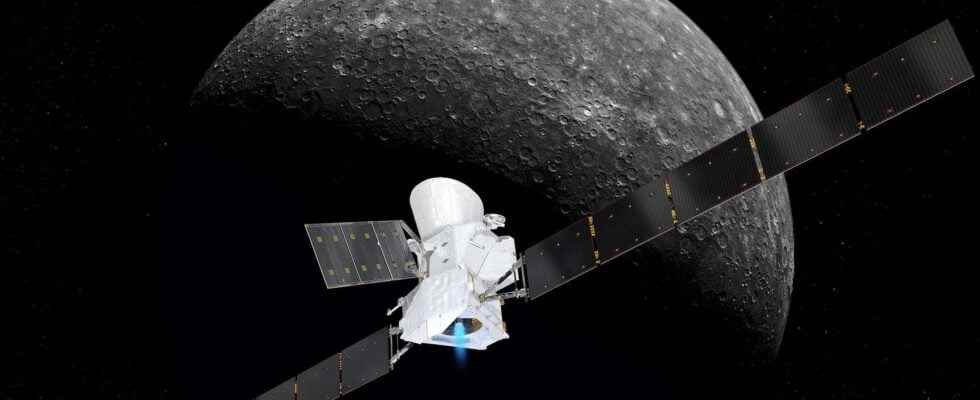A team of researchers from the University of Bern sought to model the primitive atmosphere of Mercury, created by the evaporation of the magma ocean from the young planet. The escape of this atmosphere to space, via various processes, could have had an impact on the overall makeup of the planet.
You will also be interested
[EN VIDÉO] BepiColombo’s first visit to Mercury ESA and Jaxa’s BepiColombo probe passed near Mercury on October 1, 2021, for the first time since its launch in 2018. Here are the first images of this overflight up to 199 kilometers of the small planet.
Mercury is a rather atypical planet: with a radius of 2,440 kilometers, it is the most little planet from Solar system, and also the closest to the Sun. It has the particularity of being in resonance spin-orbit 3: 2, meaning that it rotates on its axis three times every two revolutions around the Sun. Thus, its surface temperature varies from 430 ° C on the day side, to -170 ° C for the face. nocturnal. Although it is often considered that Mercury either entirely devoid ofatmosphere, there are still traces of an extremely thin atmosphere (NASA estimates that the pressure at the surface is of the order of 10-15 Pa, which is almost negligible), which would be continuously lost to space and replenished by internal sources.
A much denser atmosphere in the first moments of the planet’s life?
But, according to a new study carried out by researchers at the University of Bern, Mercury’s atmosphere could have been much denser in the early stages of the planet’s history. Their model suggests that Mercury had a magma ocean on its surface at the start of its formation, which would have evaporated under the effect of extremely high temperatures.
The existence of this ocean of magma is not really debated: it is indeed a fairly common phenomenon in the first phases of a planet’s life, because it is subject to the impacts ofaccretion towards the end of its formation which, combined with the decay of its radioactive elements, release large quantities ofenergy, and melting the surface of the planet. Due to the extreme temperatures that prevailed at that time (models indicate a surface temperature of up to 2,400 Kelvins), part of this ocean would have evaporated to form an atmosphere. In their model, the team of researchers separately studies the behaviors of volatile elements, such as carbon dioxide, hydrogen or water, behaviors of less volatile elements such as silicon, the sodium or the iron : in fact, the latter can only exist in gaseous form (such as silicon monoxide, SiO) at extremely high temperatures.
A loss of the atmosphere causing a loss in mass of Mercury?
The team then set out to determine the effect of evaporation from the ocean to the atmosphere, and the escape of this atmosphere, either to space or to the planet, on the loss of mass overall system. They point to three main mechanisms: the effect of solar wind on the atmosphere, the hydrodynamic exhaust (photoevaporation ofcash atmospheres from very high energy solar photons), and photoionization (production ofions under the effect of photons).
In their two models – one with an atmosphere made up of volatile elements, the other with an atmosphere made up of non-volatile elements – the scientists were surprised to observe that the total mass losses due to the exhaust of the atmosphere were very similar (between 1 and 4 billion kilograms per second). Considering that the magma ocean no longer contributed to the production of the atmosphere from the moment it crystallized (i.e. at around 1,500 K), the team deduced a time scale of the model of less than ten thousand. years, and therefore a total lost mass representing approximately 0.3% of the initial mass of Mercury, i.e. a little over two kilometers from crust.
It turns out that although the highly ephemeral existence of this atmosphere has really had an effect on the mass of the planet, it does not seem to have impacted the global composition of Mercury. Scientists also hoped to explain with their model the fairly high concentrations of sodium (non-volatile) on the planet’s surface, and now suspect that these concentrations were inherited from the accretion environment of Mercury very close to the Sun.
Interested in what you just read?
.
fs3
